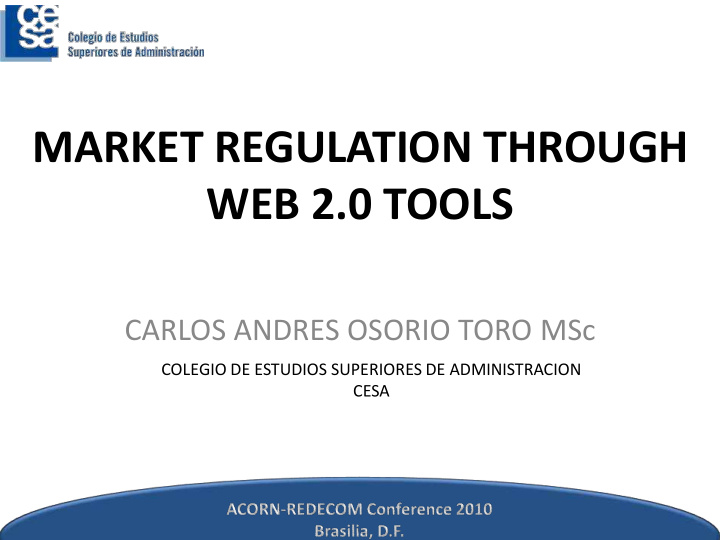



MARKET REGULATION THROUGH WEB 2.0 TOOLS CARLOS ANDRES OSORIO TORO MSc COLEGIO DE ESTUDIOS SUPERIORES DE ADMINISTRACION CESA
Schedule • Theoretical framework – Market regulation – Web 2.0 • Cases – Youtube – Facebook – Twitter • Conclusions ACORN-REDECOM Conference 2010 Brasilia, D.F.
Market Regulation ¿Are the products differenced? No Si Monopoly Not apply One ¿How many Oligopoly producers A Few are there? Perfect Monopolistic A lot Competence Competence Figure 1 Tipos de estructura de mercado (KRUGMAN, 2007) ACORN-REDECOM Conference 2010 Brasilia, D.F.
Perfect Competition • Conditions – Large number of buyers and sellers – Homogeneous products – Free entry and exit of the firms – No government regulation – Uniform price ACORN-REDECOM Conference 2010 Brasilia, D.F.
Web 2.0 Figure 2 Mapa de la web 2.0 (Fumero & Roca, 2007) ACORN-REDECOM Conference 2010 Brasilia, D.F.
Folksonomies • Collective Knowledge: Each user post content related to their interest (Definitions, links, manuals, etc) that can be complemented by other users. For instance the wikis oe del.icio.us (social bookmarking) or Taringa (Collective intelligence) • Social Content: Each user make post personal stuff as video, photos, links, or comments that share with their friends or the entire network, whose can give their approbation through votes or comments. The most known sites are YouTube, Flickr, Facebook o Twitter. • Opinion: In these sites, the users post their opinions on variable length, where talk about all kind of topics, each entry are a log: blogs =weblog, vlogs = video logs) o los podcast = audio. ACORN-REDECOM Conference 2010 Brasilia, D.F.
Youtube • Content: Audiovisual • Case : United breaks Movement Strength Effect on the producer guitars – Cause: Bad service – Effect: stock prices decrease 10 % equivalent to 180 million dollars Time ACORN-REDECOM Conference 2010 Brasilia, D.F.
Facebook • Content : Mostly text and photo in Groups, pages and events. Movement • Case: Earth hour Strength Effect on the producer – Cause: regulate energy consume – Effect: turn off the lights 1 hour in every country • Case: Social experiments – Cause: various. • Six degree experiments • Beating records • Colombia soy yo • Like / Dislike groups Time ACORN-REDECOM Conference 2010 Brasilia, D.F.
Twitter • Content: text of 140 characters about all topics Movement • Case: #InternetNecesario Strength Effect on the producer – Cause: Internet taxes in México – Effect: Not to charge the tax • Case: @Dell – Cause: Computer Outlet sales – Effect: Incomes of $6.5 million dollars • Case: @twelforce (Best buy) – Cause: Customer services – Effect: Better relationship with Time the costumer ACORN-REDECOM Conference 2010 Brasilia, D.F.
What ‘s Next • Quantitative analysis – Sources: • primary sources : – Facebook FQL. Querys to the database – Twitter searches – Youtube searches • Secondary sources – Facebakers – Twitterholic – Blogs – Expected results: • Time to have the biggest impact depending the web 2.0 tool • Common characteristics of the most important movements • Establish actors and relationships according the social network analysis. • Model to design web 2.0 strategies that really works
Conclusions • Is important to identify a common cause, situation or feelings in the people to have a lot of followers. • The users are motivated by the biggest groups, “social” causes and trends. Viral marketing. • The web 2.0 is useful as indicator to measure the campaign probability of balance the market conditions following the positive correlation between the amount of followers and the effect on the other side (producers or clients). • Who is in the group affect the credibility and the impact of the movement • Movement only work once. Replicate the idea doesn’t works. • Web 2.0 works as autoregulator media for the market. ACORN-REDECOM Conference 2010 Brasilia, D.F.
Recommend
More recommend